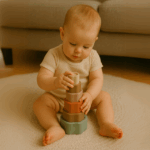Playing is not only fun for children, but also vital for their development. As a parent, you want to make sure your little one gets every opportunity to grow and learn. In this article, we take a closer look at the importance of sensorimotor toys and how they can contribute to your child's development.
The Sensomotor Development of Young Children
What is Sensomotor Development?
Sensory-motor development refers to the interaction between the senses (sensors) and motor skills (movement). It includes the way children use their bodies and senses to understand and respond to the world around them.
Key Milestones in Children's Sensomotor Development
To fully understand the benefits of sensorimotor toys, it is essential to know what milestones children typically reach during their sensorimotor development. This includes things like grasping objects, rolling, crawling, keeping balance and more.
How Sensomotor Toys Stimulate this Development
Sensomotor toys are specially designed to stimulate children's sensory perception and motor skills. It encourages them to explore, move and learn while having fun.
Types of Sensomotor Toys
There are different types of sensorimotor toys available, each aimed at developing specific skills:
Tangible toys
This includes toys with different textures, shapes and materials. It helps children develop their sense of touch and understand objects through touch.
Motion toys
Movement toys encourage children to roll, crawl, balance and move. This improves their gross motor skills and coordination.
Sensory toys
This type of toy focuses on the senses, such as toys with sounds, bright colours and soft lighting. It helps children refine their sensory perception.
Creative toys
Creative toys include craft and construction sets that allow children to use their imagination and develop fine motor skills.
The Benefits of Sensomotor Toys
Using sensomotor toys has numerous benefits for your little one's development:
Improved Motor Skills
Sensomotor toys help develop gross and fine motor skills, which are essential for activities such as walking, writing and self-care.
Enhanced Sensory Perception
Children learn more about the world around them by using their senses. Sensomotor toys enhance this perception.
Cognitive and Emotional Development
It also stimulates cognitive development by encouraging problem-solving thinking and creativity. Moreover, playing with others can promote social and emotional development.
Social Interaction and Collaboration
Sensomotor toys can encourage children to play, share and interact together, developing valuable social skills.
How to Choose the Right Sensomotor Toys?
When choosing sensomotor toys for your child, there are some important considerations:
Age-related Choices
Make sure the toys are suitable for your child's age so that they are challenging but not too difficult.
Safety and sustainability
Check that the toy is safe, with no sharp edges or small parts that can be swallowed. Durability is also important so that it lasts a long time.
The Importance of Variety
Offer a variety of sensory-motor toys to encourage different skills and prevent boredom.
Practical Tips for Use
Playing and Participating in Activities Together
Play actively with your child to increase their engagement and share fun. Encourage interaction by asking questions and talking about what they discover.
Integrating Sensomotor Toys into the Daily Routine
Integrate sensorimotor toys into daily activities, such as while bathing or eating, to promote development without investing extra time.
Finding the Balance between Supervised and Free Play
Offer both structured activities and free play time so that your child can explore and learn at their own pace.
Sensory-motor toys are a crucial tool for your child's development. By making the right choices and actively participating in your little one's play, you can support their growth and development in many ways. It is important to remember that each child develops at their own pace, so be patient and always encourage their efforts.
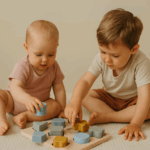 Puzzles
Puzzles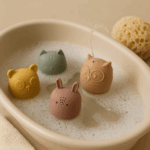 Water toys
Water toys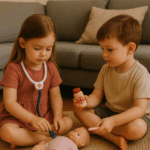 Role-playing toys
Role-playing toys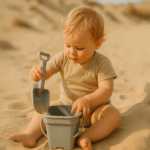 Sand toys
Sand toys